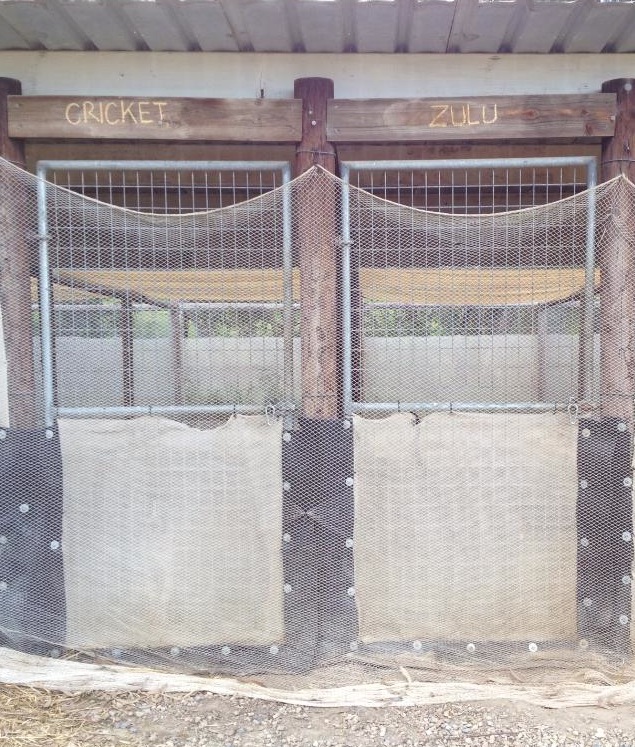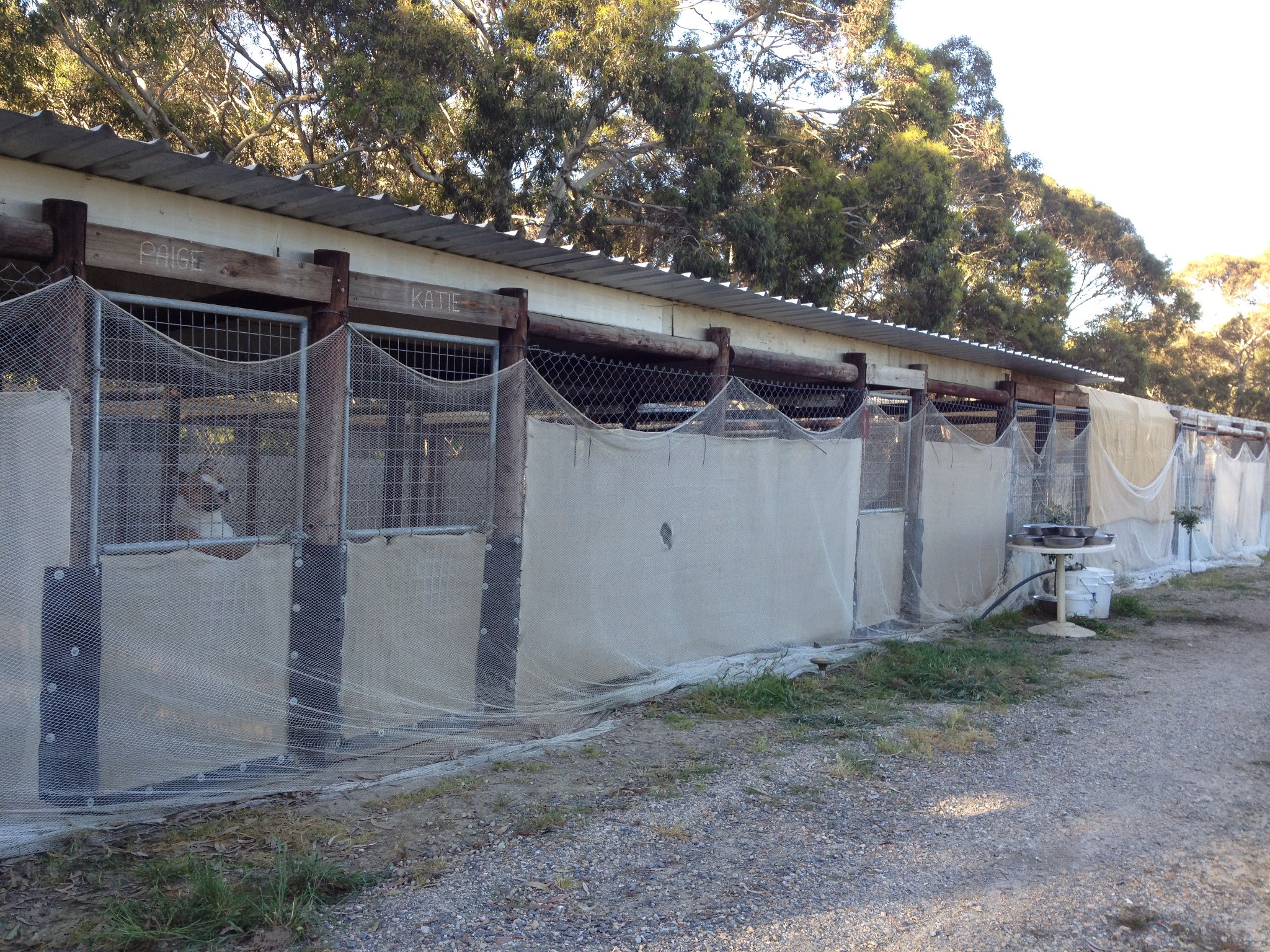Many animal welfare groups call for legislation that defines what ‘best practice’ is for breeders. They state that their goals are to eradicate any suffering of animals used for breeding. While I, too, am concerned about the wellbeing of animals, this concern extends to all dogs, and not only those used for breeding practices. Because of this, I advocate for animal welfare legislation to be upheld nation-wide. While I certainly want to discourage individuals motivated solely by profit and romantic ideals from breeding dogs, I do not want to see committed, knowledgable and ethical breeders removed from their hobby.
However, this is exactly what dog breeding legislation seems to be doing in Australia.

Puppies, on grass, with two adult dogs: Sin! According to Australian breeders legislation.
Nationally, here are two significant pieces of legislation regarding dog breeding, though both are only applicable to certain areas. There is the Gold Coast’s “Breeder Code of Practice” which targets anyone with entire dogs, and, in NSW, there is the “Breeding Dogs and Cats – Code of Practice“, which targets anyone breeding animals. These codes seem to have been developed in consultation with one another, because they are very similar in a lot of ways. Significantly, both codes have ‘standards’, which are enforceable, and ‘guidelines’, which are just recommendations on breeding animal husbandry.
Commercial Breeding Establishments Only
Both the Gold Coast and NSW document is written in a way that obligates people to keep their animals in kennels and concrete enclosures. They define breeding establishments as being purpose built (NSW), the floor as being ‘non-porous’ (GC), that needs to be disinfected weekly (NSW & GC), and run off into a sewage system (NSW).
I know what this is trying to do – it’s trying to stop people with a large number of dogs running in muddy and faeces-laden runs. However, this legislation targets anyone who breeds dogs (NSW) and anyone with an entire dog (GC). This means that people who keep and raise dogs and puppies in their home are effectively illegal.
For example, my puppies are raised in the dining room – an excellent place for puppies to socialise to general household ruckus. However, my dining room was not purpose built for puppy rearing, it is not disinfected weekly (though it is cleaned daily when housing puppies), and it doesn’t have a drain, let alone a drain to a sewage system. This means I wouldn’t, legally, be able to raise puppies in a home environment while in NSW or the Gold Coast. To follow legislation, my puppies would have to be raised in a purpose built enclosure outside or in a shed, something I think is hugely undesirable and indeed detrimental to the psychological development of puppies (it would produce what Ian Dunbar calls ‘Lemon Puppies‘).
Effectively, both these pieces of legislation have made-illegal the practice of raising puppies in a home environment. The alternative is raising puppies in a kennel environment, and that just doesn’t make sense considering what we know on the importance of puppy socialisation. However, considering the NSW legislation also says that puppies “must not be separated from their mother until 7 weeks”, it seems that the legislation has zero interest in producing amicable, sociable, independent, and well-rounded puppies.
Dogs Can No Longer Be Crated
Both schemes specify minimum sizes for animal enclosures. The Gold Coast calls for the dog to be able to move away from its bed to urinate and defecate. This legislation pretty much means that crates cannot be used, as they are smaller than the minimum enclosure sizes specified. Considering the benefits of crate training, why would legislation be introduced to delegalise it?
The minimum enclosure sizes increase for the number of puppies, which makes sense, except it doesn’t define an age. This means they require a bitch with puppies to be housed in a minimum area of 3.5 metre square area (NSW). I often lock a bitch in a 1 metre square area with their puppies during the first week or two, because otherwise I find bitches neglectful of their puppies. It, of course, depends on the individual bitch, but with legislation such as this in force, I can’t make decisions based on these individuals. I am serious when I say that not locking Clover in with her puppies would almost undoubtly have resulted in puppy death – but this would be contravening the legislation in NSW that requires bitches to be able to escape their young. How is that in the best interest of animal welfare?
Co-Habitation of Animals is Foggy
Both pieces of legislation are a bit unclear, but seem to suggest that animals should be isolated from one another. The Gold Coast Scheme asks for enclosures to be “disinfected between animals”, which implies that two animals may not share a run. The NSW legislation requires bitches in season to be “isolated from other animals”, a truly bizarre request. I wonder if the writers of the legislation realise that bitches require an entire and fertile male dog to get pregnant, so can run with any dog that doesn’t fit that description and avoid pregnancy?
In kennel situations, having a dog companion is important to enriching the day-to-day life of that dog. Furthermore, for young puppies, having dog-dog play is important for developing bite inhibition. And, again, for the hobby breeder at home, running dogs together is a natural part of dog ownership. It doesn’t make sense that people with two or more pet dogs can run them together, but having two or more breeding animals means that this is no longer an option.
Elements of Mandatory Desexing
I have already discussed the implications of mandatory desexing schemes, and both these schemes stink of mandatory desexing. The Gold Coast scheme even says “A permit condition may require the holder of the permit to desex an entire female animal which the holder of the animal has retired from breeding”. Yuck! This comes back to considering the well being of individual animals (is desexing really in their best interest?).
Arbitrary Limits for Animal Welfare
Both schemes have, with no real basis, decided that numbers determine bitch welfare. For example, in the Gold Coast, a bitch is clearly compromised if she has more than 4 litters, and if she is older than 6 years old. In NSW, a bitch can’t be mated on their first cycle, regardless of their age. Of course, I wouldn’t advocate breeding a bitch at 6 months, but many bitches don’t come in until they’re 18 months or older. What hazard does pregnancy in a bitch’s first cycle cause? While these strange numerical scales are probably good guides in general, they are by no means indicative of animal welfare.
Double Standards
I find it ironic that the Gold Coast scheme says that “Euthanasia of cats and dogs is only acceptable for the relief of incurable illness, chronic pain, and suffering”, yet the RSPCA of QLD euthanises 30% of dogs and puppies that come into their care and 44% of cats and kittens (according to their 2011/2012 annual report). Why are breeders, whose ‘job’ is to breed animals, held to a higher standard than shelters, who’s job it is to shelter and protect them? Furthermore, the scheme calls for secure enclosures, yet the RSPCA QLD admits to having 15 dogs escape throughout the course of the year (again in the 2011/2012 annual report). Can you say “what the”?
Weird Inclusions
Some parts of the scheme are just plain weird. In the Gold Coast you are allowed to tether animals (known to increase aggression in dogs), but you can’t microchip them before 8 weeks of age…
In NSW, breeders need to record keep everything, have emergency procedures for evacuation documented, and have functioning fire righting equipment. All very excessive for a home, hobby breeder.

Puppy on grass! Legislation wants this banned!
So what does this mean?
While animal welfare groups who push for breeder standards have good intentions, so far, no legislation has been produced that does anything other than legitimise the practice of kennelling dogs and raising puppies in kennel environments. While I would not argue that all kennel environments are ‘bad’ for dogs, they certainly fall short of socialisation that can be achieved in a home environment, and so fall short of producing the best puppies that they can.
Breeders have a responsibility to care for the wellbeing of their animals – but disinfectant, concrete floors, and isolated animals isn’t necessarily indicative of animal welfare. Dog welfare is as much as the psychological aspects of keeping and raising good dogs: Selecting appropriate parents with good temperaments, providing enriching environments, socialisation and toilet training of puppies, and monitoring their dogs for life.
If socialisation was mandated, I would be all for it. If breeders were responsible for their animals for life, that would be awesome.
Making breeders keep their animals in kennels instead of houses is just backwards to everything we know about dog welfare.
Further Reading:
Can Breeders Breed Better?
The Sin of Breeding Dogs
The Fallacy of Mandatory Desexing
What is the answer (to puppy farms)?




